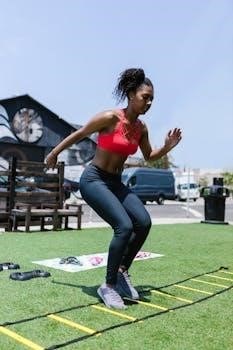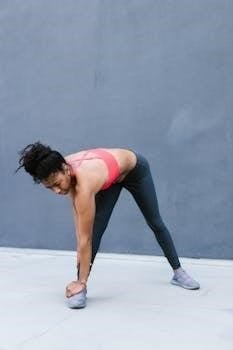Bodyweight Exercises PDF⁚ A Comprehensive Guide

This comprehensive guide unveils the power of bodyweight exercises. It provides accessible routines for all fitness levels. Focusing on strength‚ athleticism‚ and endurance‚ the guide emphasizes the versatility and effectiveness of using your own body as resistance. Downloadable PDFs offer structured plans for achieving fitness goals‚ anytime‚ anywhere.
Bodyweight training‚ a timeless fitness method‚ utilizes your own weight for resistance. This approach‚ embraced by athletes and soldiers throughout history‚ offers a practical and effective way to build strength‚ lose fat‚ and enhance endurance. Unlike gym workouts requiring equipment‚ bodyweight exercises can be performed anywhere‚ anytime‚ making fitness accessible to everyone.

This guide delves into the fundamentals of bodyweight training‚ providing a structured approach for beginners and advanced practitioners alike. We’ll explore various exercises‚ from basic squats and push-ups to more challenging movements‚ ensuring a well-rounded workout. Moreover‚ we will show how to make a routine to fit your needs.
The beauty of bodyweight training lies in its scalability; exercises can be modified to suit individual fitness levels. As you progress‚ you can increase the difficulty by adding repetitions‚ sets‚ or variations. Whether your goal is to improve functional fitness‚ enhance core strength‚ or simply maintain a healthy lifestyle‚ bodyweight training offers a versatile and rewarding path to achieving your objectives. Get ready to unlock your fitness potential with the power of your own body.
Benefits of Bodyweight Exercises
Bodyweight exercises offer a multitude of advantages‚ making them a cornerstone of any effective fitness regimen. Firstly‚ they require no equipment‚ eliminating gym memberships and allowing you to workout anywhere‚ anytime. This convenience fosters consistency‚ a key element in achieving fitness goals. Secondly‚ bodyweight movements are functional‚ mimicking real-life activities and improving overall mobility and coordination.
Furthermore‚ these exercises engage multiple muscle groups simultaneously‚ promoting balanced strength development and enhancing core stability. This holistic approach reduces the risk of injury and improves posture. Bodyweight training is also scalable‚ allowing you to adjust the difficulty based on your fitness level. Beginners can start with basic exercises and gradually progress to more challenging variations.

Beyond physical benefits‚ bodyweight exercises can boost mental well-being. The sense of accomplishment after completing a challenging workout enhances self-esteem and reduces stress. By incorporating bodyweight training into your routine‚ you’ll experience increased strength‚ improved endurance‚ greater flexibility‚ and a heightened sense of overall wellness. It’s a simple‚ effective‚ and accessible way to transform your body and mind.
Bodyweight Exercises for Beginners
Embarking on a fitness journey with bodyweight exercises is an excellent choice for beginners. The accessibility and scalability of these movements make them ideal for building a solid foundation. Start with fundamental exercises like squats‚ push-ups (modified on your knees if needed)‚ lunges‚ and planks. These exercises engage major muscle groups‚ improving strength and stability.
Focus on proper form over quantity. Mastering the correct technique ensures you’re targeting the right muscles and preventing injuries. Begin with a few repetitions of each exercise‚ gradually increasing as you get stronger. Remember to listen to your body and rest when needed. Consistency is key‚ so aim for regular workouts‚ even if they’re short.
Incorporate warm-up exercises like arm circles and hip flexor stretches to prepare your body for the workout and cool-down stretches to improve flexibility and reduce muscle soreness. As you progress‚ explore variations of these exercises to challenge yourself further. Bodyweight training for beginners is about building a strong base‚ fostering good habits‚ and enjoying the process of getting fitter and healthier. With dedication and patience‚ you’ll see significant improvements in your strength‚ endurance‚ and overall well-being.
Sample Beginner Bodyweight Workout Routine
This sample routine provides a structured introduction to bodyweight training for beginners. Start with a 5-10 minute warm-up‚ including light cardio like jogging in place and dynamic stretches such as arm circles and leg swings. This prepares your muscles and joints for the workout ahead.
Begin with bodyweight squats⁚ perform 2-3 sets of 10-12 repetitions. Next‚ move on to push-ups‚ modifying on your knees if necessary‚ aiming for 2-3 sets of as many repetitions as possible (AMRAP). Follow with lunges‚ 2-3 sets of 10-12 repetitions per leg. Incorporate planks‚ holding for 30-60 seconds for 2-3 sets. Finally‚ include jumping jacks‚ 2-3 sets of 15-20 repetitions for a cardio burst.
Cool down with 5-10 minutes of static stretches‚ holding each stretch for 20-30 seconds. Focus on stretching the major muscle groups worked‚ such as quads‚ hamstrings‚ and chest. Perform this routine 2-3 times per week on non-consecutive days‚ allowing for rest and recovery between workouts. Remember to listen to your body and adjust the routine as needed. Consistency and proper form are crucial for building strength and preventing injuries.
Intermediate Bodyweight Exercises
Once you’ve mastered the basics‚ progress to intermediate bodyweight exercises to further challenge your strength and endurance. These exercises require more coordination and stability‚ building upon the foundation established in beginner routines. Incorporate these into your workouts gradually‚ focusing on proper form before increasing repetitions or sets.
Elevate your push-ups by performing decline push-ups‚ placing your feet on an elevated surface to increase upper body engagement. Try pistol squats‚ a single-leg squat that demands significant balance and leg strength; start with assisted versions if needed. Introduce pull-ups or chin-ups‚ using a sturdy bar and focusing on controlled movements. Progress to plyometric exercises like jump squats and lunge jumps for explosive power.
Add complexity to your core work with exercises like Russian twists and bicycle crunches. Incorporate the inchworm exercise‚ combining a hamstring stretch with a plank and push-up. Remember to maintain a strong core throughout each movement. Aim for 3-4 sets of 10-15 repetitions for most exercises. As you get stronger‚ consider adding weight vests or resistance bands to further increase the intensity. Always prioritize proper form to avoid injuries.
Advanced Bodyweight Exercises
For seasoned fitness enthusiasts‚ advanced bodyweight exercises offer a formidable challenge‚ pushing the limits of strength‚ control‚ and coordination. These movements demand exceptional body awareness and a solid foundation built upon consistent training. Before attempting these exercises‚ ensure you can comfortably perform intermediate variations with perfect form.
Explore one-arm push-ups‚ requiring immense upper body strength and stability; start with assisted variations against a wall. Master the freestanding handstand‚ a testament to balance and core control; practice against a wall initially. Attempt muscle-ups‚ combining a pull-up and a dip‚ demanding explosive power and coordination. Incorporate dragon flags‚ an advanced core exercise targeting the entire abdominal region; start with regressions on a decline bench.
Try pistol squats on an elevated surface‚ increasing the range of motion and difficulty. Add plyometric variations like clapping push-ups and box jumps for explosive power. Remember to prioritize controlled movements and proper form over speed or repetitions. Aim for lower repetitions with impeccable technique. Consider incorporating weighted vests or resistance bands to further increase the intensity. Always warm up thoroughly and listen to your body‚ progressing gradually to avoid injuries. Advanced bodyweight training requires dedication and patience‚ but the rewards in strength and athleticism are well worth the effort.
Creating a Personalized Bodyweight Workout Plan
Crafting a personalized bodyweight workout plan is key to achieving your unique fitness goals effectively and sustainably. Start by defining your objectives⁚ Are you aiming for strength gains‚ fat loss‚ increased endurance‚ or overall fitness improvement? Once you have a clear understanding of your goals‚ assess your current fitness level. Be honest about your strengths and weaknesses to choose appropriate exercises and progressions.
Select exercises that align with your goals and fitness level‚ including variations that challenge you without compromising form. Structure your workouts with a warm-up‚ a main workout consisting of compound and isolation exercises‚ and a cool-down. Plan your workout schedule‚ considering your lifestyle and recovery needs‚ aiming for consistency over intensity. Track your progress by recording your sets‚ reps‚ and exercises to monitor improvements and make adjustments as needed.
Incorporate progressive overload by gradually increasing the difficulty of your exercises‚ either by adding repetitions‚ sets‚ or more challenging variations. Listen to your body and prioritize rest and recovery to prevent injuries and burnout. Stay flexible and adapt your plan as your fitness level evolves and your goals change. Remember‚ consistency‚ proper form‚ and a personalized approach are the cornerstones of a successful bodyweight training journey.
Bodyweight Exercises for Strength
Bodyweight exercises can be remarkably effective for building strength‚ challenging your muscles in unique ways and promoting functional fitness. The key lies in focusing on exercises that provide sufficient resistance and utilizing progressive overload techniques to continually challenge your muscles. Compound exercises like squats‚ push-ups‚ lunges‚ and rows are excellent choices for building overall strength‚ engaging multiple muscle groups simultaneously.
To increase the intensity of bodyweight exercises‚ consider variations that increase the leverage or stability demands. For example‚ progress from standard push-ups to incline‚ decline‚ or diamond push-ups. Elevate your feet during squats to target your glutes and hamstrings more effectively. Implement single-leg variations to challenge your balance and stability while increasing the load on the working leg.
Incorporate plyometric exercises like jump squats and plyo push-ups to develop explosive power and strength. Focus on proper form and controlled movements to maximize muscle activation and minimize the risk of injury. Perform exercises with a slow‚ deliberate tempo to increase time under tension‚ further stimulating muscle growth and strength gains. Remember‚ consistency‚ challenging variations‚ and a focus on proper technique are essential for building strength through bodyweight training.
Bodyweight Exercises for Fat Loss
Bodyweight exercises are a powerful tool for fat loss. They can be performed anywhere‚ anytime‚ making them accessible and convenient. The key to using bodyweight exercises for fat loss lies in creating a calorie deficit through increased energy expenditure. High-intensity interval training (HIIT) with bodyweight exercises is particularly effective. Combine exercises like burpees‚ jumping jacks‚ mountain climbers‚ and high knees in short bursts with brief rest periods to maximize calorie burn.
Compound bodyweight exercises‚ such as squats‚ lunges‚ push-ups‚ and planks‚ engage multiple muscle groups‚ increasing metabolic demand and promoting fat loss. Circuit training‚ where you perform a series of exercises back-to-back with minimal rest‚ is another effective approach. Focus on maintaining a fast pace and challenging yourself to complete as many repetitions as possible within a given time frame.
Incorporate cardio bodyweight exercises like jogging in place‚ butt kicks‚ and skipping to elevate your heart rate and burn more calories. Remember‚ consistency is crucial; Aim for at least 30 minutes of bodyweight exercise most days of the week. Combine bodyweight training with a healthy‚ calorie-controlled diet for optimal fat loss results. Stay hydrated and listen to your body to prevent overtraining and injuries.
Bodyweight Exercises for Endurance
Bodyweight exercises are an excellent way to build endurance‚ enhancing your body’s ability to sustain physical activity over extended periods. These exercises improve cardiovascular health and muscular stamina. To maximize endurance gains‚ focus on high-repetition sets with minimal rest. Circuit training is particularly effective; design circuits with exercises like squats‚ lunges‚ push-ups‚ and planks‚ performing each exercise for a set duration or number of repetitions before moving to the next.
Incorporate plyometric exercises such as jumping jacks‚ burpees‚ and squat jumps to develop explosive power and cardiovascular fitness. These exercises elevate your heart rate and improve your body’s ability to efficiently use oxygen. Increase the duration of your workouts gradually‚ adding a few minutes each week to challenge your endurance further. Consistency is key; aim for at least three to four bodyweight endurance workouts per week.
Focus on proper form to prevent injuries‚ especially as fatigue sets in. Listen to your body and take rest days when needed. Combine bodyweight endurance training with other forms of cardiovascular exercise‚ such as running or swimming‚ for a well-rounded fitness routine. Remember‚ building endurance takes time and dedication‚ so be patient and persistent with your training efforts.
Bodyweight Training and Nutrition
Nutrition plays a crucial role in maximizing the benefits of bodyweight training. Fueling your body with the right nutrients is essential for energy‚ muscle recovery‚ and overall performance. A balanced diet rich in protein‚ carbohydrates‚ and healthy fats supports muscle growth and repair. Protein is particularly important for rebuilding muscle tissue after workouts; aim for 0.8 to 1 gram of protein per pound of body weight.
Carbohydrates provide the energy needed for intense training sessions. Choose complex carbohydrates like whole grains‚ fruits‚ and vegetables for sustained energy release. Healthy fats‚ such as those found in avocados‚ nuts‚ and olive oil‚ support hormone production and overall health. Hydration is also critical; drink plenty of water throughout the day‚ especially before‚ during‚ and after workouts.
Consider timing your meals to optimize performance and recovery. Eating a meal or snack containing both protein and carbohydrates within an hour after training can help replenish glycogen stores and initiate muscle repair. Avoid processed foods‚ sugary drinks‚ and excessive amounts of unhealthy fats‚ as these can hinder your progress. Tailor your nutrition plan to your specific goals‚ whether it’s building muscle‚ losing fat‚ or improving endurance. Consult with a nutritionist or registered dietitian for personalized guidance.
Common Mistakes to Avoid in Bodyweight Training
Bodyweight training‚ while effective‚ can lead to injuries and plateaus if performed incorrectly. One common mistake is neglecting proper form. Maintaining correct posture and alignment is crucial to prevent strain and maximize muscle engagement. Avoid rushing through exercises; focus on controlled movements throughout the full range of motion. Another mistake is skipping the warm-up. Warming up prepares your muscles and joints for exercise‚ reducing the risk of injury.
Not progressing gradually is another pitfall. As you get stronger‚ challenge yourself by increasing the difficulty of the exercises or the number of repetitions. However‚ avoid jumping too quickly to advanced variations‚ as this can lead to overuse injuries. Ignoring muscle imbalances is also common.
Ensure you’re working all muscle groups equally to prevent imbalances that can affect your posture and increase injury risk. Overtraining is another mistake to avoid. Rest and recovery are essential for muscle repair and growth. Listen to your body and take rest days when needed. Finally‚ not incorporating variety into your workouts can lead to boredom and plateaus. Mix up your routine with different exercises and training styles to keep your body challenged and engaged. By avoiding these common mistakes‚ you can maximize the benefits of bodyweight training and achieve your fitness goals safely and effectively.
Bodyweight Exercise Resources (PDFs and Online Tools)
Numerous resources are available to enhance your bodyweight training journey. PDFs offer structured workout plans‚ exercise guides‚ and visual aids‚ perfect for offline access. Many websites and apps provide interactive tools‚ video demonstrations‚ and personalized training programs. DAREBEE stands out with its extensive collection of bodyweight workouts‚ categorized by muscle group‚ difficulty level‚ and training goal. Their PDFs offer detailed instructions and illustrations for each exercise.

Other websites provide workout generators‚ allowing you to create custom routines based on your fitness level and preferences. YouTube channels feature expert trainers demonstrating proper form and offering workout ideas. Fitness apps track your progress‚ provide motivation‚ and connect you with a community of fellow bodyweight enthusiasts.
These resources often include features like timers‚ rep counters‚ and exercise logs to help you stay organized and accountable. Online forums and social media groups offer platforms to share experiences‚ ask questions‚ and receive support from others. Before starting any new workout program‚ consult a healthcare professional or certified trainer to ensure it’s safe and appropriate for you. By leveraging these resources‚ you can optimize your bodyweight training‚ achieve your fitness goals‚ and stay motivated along the way. Remember to choose resources that align with your individual needs and learning style.